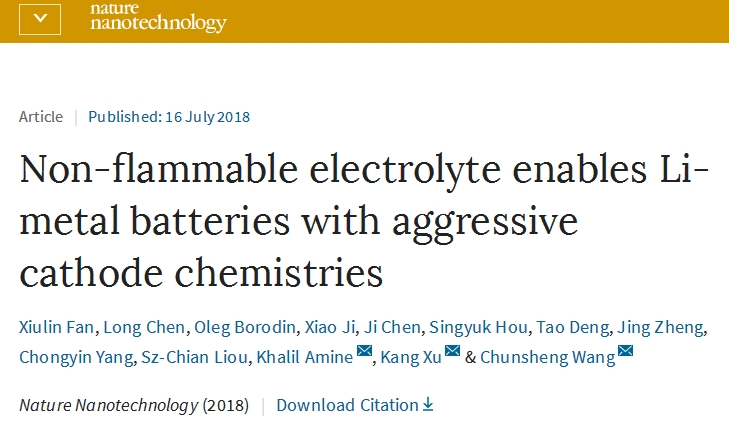Search Product
Structure Search
Search
Advantage Products
Location: Industrial Info
High fluorine electrolyte—high voltage non-flammable lithium metal battery electrolyte
2018-07-23
来源:转载自第三方
23 July 2018
Recently, researchers at the University of Maryland, the US Army Research Laboratory, and the Argonne National Laboratory have implemented high-efficiency circulation of metal negative electrodes and high-capacity high-voltage positive electrodes in highly fluorinated electrolytes (1M LiPF6 FEC/FEMC/HFE). A related study entitled "Non-flammable electrolyte capable Li-metal batteries with aggressive cathode chemistries" [1] was published in the new issue of Nature Nanotechnology.

Lithium-powered batteries are new high-energy batteries that were successfully developed in the 20th century and became practical in the 1970s. Because of its high energy, high battery voltage, wide operating temperature range and long storage life, it is a research hotspot in the world and has been widely used in military and civilian small appliances.
However, although lithium metal has a high theoretical capacity and a negative potential, it is extremely active and can react spontaneously with the electrolyte to form SEI film and lithium dendrites, resulting in an increase in side reactions, posing a safety hazard and greatly shortening the cycle life of the battery; In order to greatly increase the energy density of lithium-ion batteries, it is necessary to utilize a higher energy density cathode material, but at present, no electrolyte can simultaneously thermodynamically stabilize the high-voltage cathode material and the low-voltage anode material of the lithium ion battery. Therefore, to further increase the energy density, it is necessary to develop a new electrolyte to match the higher voltage cathode material, and also to match the lithium metal anode material.
In this study, the researchers used a non-flammable fluorinated electrolyte, 1M LiPF6 FEC/FEMC/HFE. During the circulation, the fluorinated electrolyte forms a LiF-based SEI on the lithium metal side, and forms a fluorine-containing composite-based CEI on the positive electrode side. Fluoride has the strongest binding energy among all the compounds, the lowest electronic conductance, the highest thermodynamic stability, greatly inhibits the continuous side reaction of the electrolyte and the positive and negative materials, and expands the positive and negative windows of the electrolyte, realizes high-efficiency cycling of lithium metal and high-voltage cathode materials, even charging and discharging up to 1,000 times, while the storage capacity is only reduced to the original 93%. At the same time, the highly fluorinated electrolyte greatly inhibits the flammability of the electrolyte system and greatly improves the safety performance of the battery system.
Researchers have demonstrated their properties with button cells as experimental batteries. At present, they are working with business partners to further optimize and debug batteries that use this electrolyte to produce higher voltages. It is believed that this technology will promote the further development of the electric vehicle industry.
References
[1] Xiulin Fan, Long Chen, Oleg Borodin, et al. Non-flammable electrolyte capable Li-metal batteries with aggressive cathode chemistries. Nature Nanotechnology, 2018.
Related links: LiPF6
Edited by Suzhou Yacoo Science Co., Ltd
如果涉及转载授权,请联系我们。












